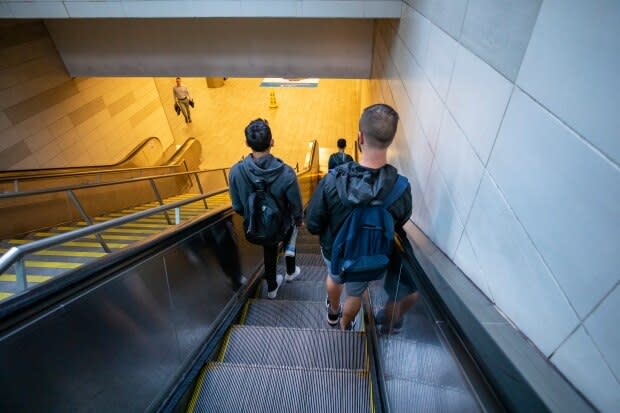Vancouver, you're using escalators wrong, but that's (mostly) OK
There's an unwritten rule for taking escalators in Vancouver. People stand on the right side or walk on the left. Makes sense, right?
Well it turns out this is a very inefficient, and possibly dangerous way to use an escalator.
Think of escalators like those at SkyTrain stations. They move more people when people are packed closely together. At their maximum capacity, with two people on each step, escalators can move about 13,500 people per hour.
But in reality, this number is closer to 7,000-7,500 people and a big reason is because people who walk are taking up more room. They tend to take up three steps per person while those who stand take up two.
On top of that, there just aren't that many people walking up escalators.
A study in London found 74.9 per cent of people choose to stand instead of walking, especially on the longer ones. With this 'stand on the right, walk on the left' rule, we're giving up 50 per cent of the space on our escalators for roughly 25 per cent of our commuters.

Look for this problem next time during rush hour where the "standing" side of the escalators ends up with a line of people trying to get on. It may seem counterintuitive, but people who are walking up escalators to save seconds off their commute are actually slowing everyone else down.
Efficiency aside, there's another reason why walking on escalators might be a bad idea—safety. Escalator accidents are much more common than you think.
A CBC investigation found that escalator accidents happen every second day in the Montreal Metro. In the U.S., about 10,000 escalator-related injuries end in emergency room visits every year.
Many of those victims were likely walking. A study in Tokyo found almost 60 per cent of escalator accidents between 2013 and 2014 resulted from people using escalators improperly, which includes people walking or running on them.
Otis, a manufacturer of escalators (and the trademark owner of the word escalator) actually recommends users stand in the middle of the escalator with hands on both railings for maximum safety.
Finally, the poor escalators are struggling under the uneven human weight. In 2017, the subway operator in Nanjing, China, reported 95 per cent of their escalators were experiencing severe wear and tear on the right side.

I was curious whether this was an issue in Vancouver so I asked Translink about it.
A spokesperson kindly replied: "More users standing on the right can affect some escalators, particularly ones that are longer with higher traffic volumes. This is seen only anecdotally after several years of use. We don't encourage customers to walk on escalators. They're meant to be used while standing still with a hand on the handrail."
So what should we do? Force Vancouverites to stand on both sides?
This feels a bit anticlimactic, but I don't think we need to do anything. Journalists (including myself) love preaching to people that something is wrong, or that they're doing something wrong. But sometimes the facts are a lot more sobering.
Assuming escalators carry 7,000-7,500 people per hour, even with the 'stand on the left, walk on the right' rule, our SkyTrain stations don't see anywhere near the number of commuters to seriously clog them up.
Passenger traffic at station's busiest hours:
Waterfront Station has just over 6,000 passengers
Granville Station has 4,300
Vancouver City Centre has just under 3,000
And Commercial-Broadway has 2,650

Congestion on our escalators is likely only an issue at the busiest SkyTrain stations, with the longest escalators, and only during peak times.
We could ask people to stand on both sides of an escalator during specific times at specific stations, but I'm not even sure if the effort would be worth it for a rather small increase in efficiency.
So go ahead, walk up the escalator with a clear conscience, but do so at your own risk. I'm taking the stairs.
To hear the complete interview with Uytae Lee on The Early Edition, click on the audio link below:
This column is part of CBC's Opinion section. For more information about this section, please read our FAQ.


